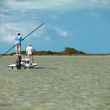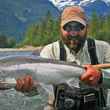Newcomers to the sport of fly fishing can feel overwhelmed and lost at times. The challenges faced by the novice fly fisherman can be significant and the lack of positive feedback from successfully enticing a fish to take your imitation can make the prospect of learning the ropes a daunting one. Especially here in the eastern United States where the fish populations are lower and pressure is higher, more selective, more "educated" fish can make the task facing the unexperienced fisherman seem, at times, impossible.
Take for example my experience last week on the West Branch of the Delaware River, albeit one of the most technical and difficult rivers to fish anywhere in the United States. After a day of nothing much at all except prospecting with nymphs and streamers under sunny skies and through low, gin clear water, fish began to rise readily after the sun dipped below the horizon and a number of bugs appeared on the river. With at least a dozen fish to target from my spot in the river, surely success was about to be had, no? No. With no less than 6 different bugs on the water and in various life stages, the next hour was spent blowing through patterns and rigs and all to no avail. Walking off the river in the dark and straddling a boulder in the process, led to a pathetic, helpless slide into the water and a pair of filled up waders.





























